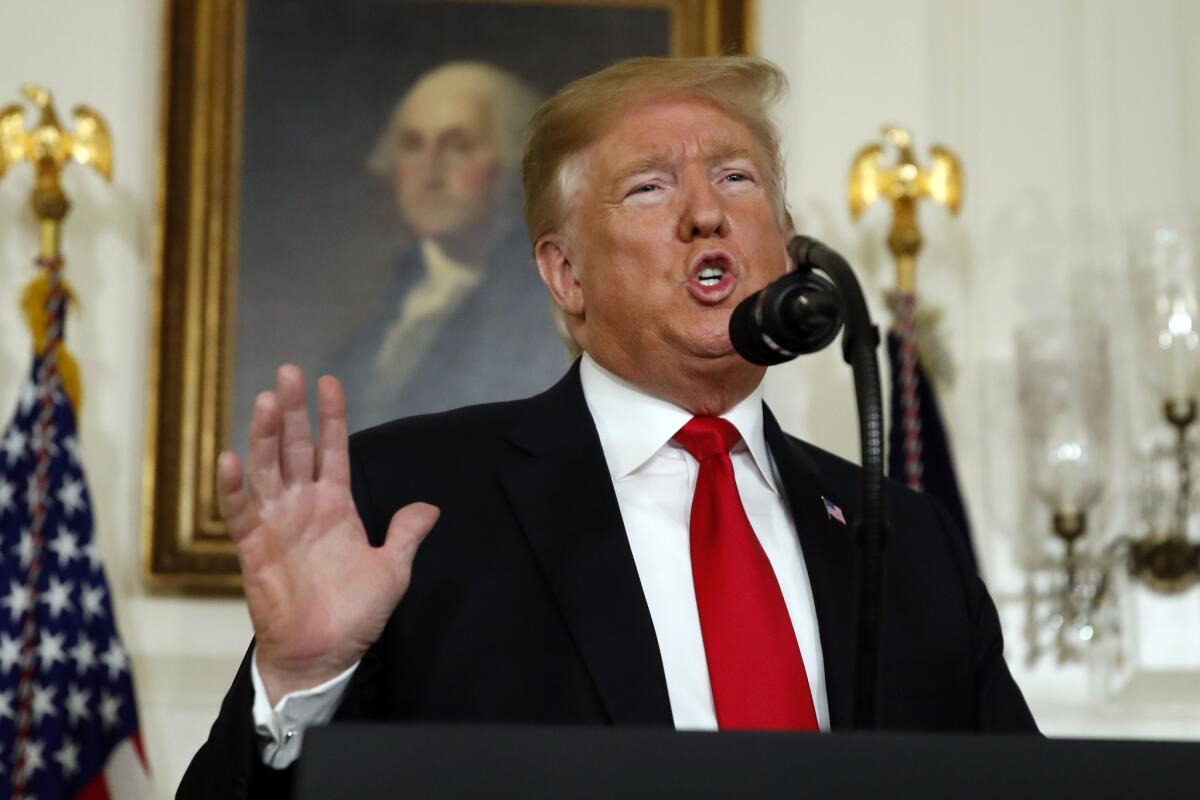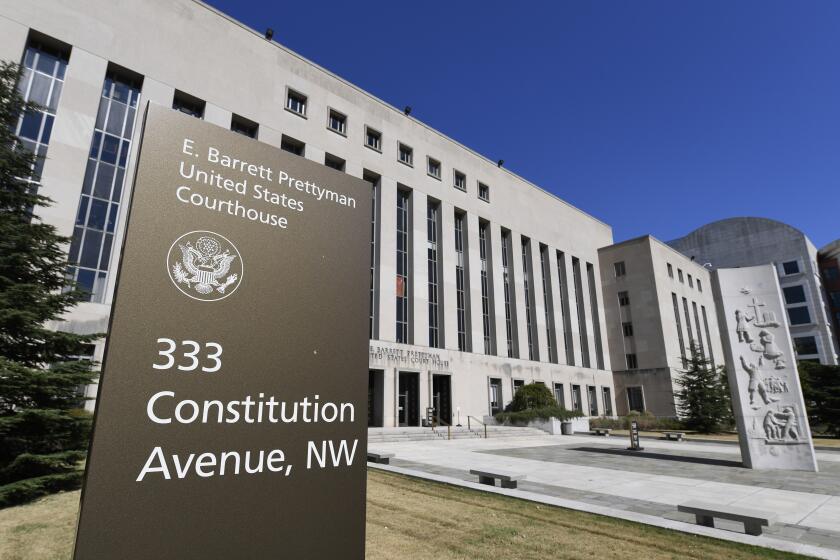Trump offers to temporarily protect ‘Dreamers’ if Democrats fund his wall

- Share via
Reporting from Washington — President Trump on Saturday suggested a compromise for fully reopening the government that would temporarily protect certain refugees and immigrants who came to the U.S. illegally years ago as children if Democrats back a scaled-down version of his proposed border wall.
The proposal, which Senate Majority Leader Mitch McConnell (R-Ky.) plans to bring up for a vote within days, almost certainly won’t be enough to end the standoff that has closed government agencies for more than four weeks, depriving some 800,000 workers of paychecks. Even before Trump spoke, Democrats rejected his offer as inadequate.
But, along with steps by Democrats in the House to provide additional money for border security, it marked the first moves toward compromise after days in which the tension between Trump and House Speaker Nancy Pelosi ratcheted up significantly and no negotiations took place between them.
In notable contrast with his statements over past weeks, Trump’s televised address from the White House Diplomatic Reception Room included no direct jabs at Democratic leaders. Instead, he called repeatedly for “compromise,” saying that “both sides” should “put down their armor.”
He also, more explicitly than ever, acknowledged the reality that his current plans are a far cry from his campaign pledge of a wall along the entire southern border. The current proposal would provide a $5.7-billion installment to build steel fencing along 230 miles of the frontier, he said. As recently as December, Trump emphatically denied that he’d abandoned his idea of a concrete wall, after his former chief of staff, John F. Kelly, said otherwise in an interview with The Times.
It’s “not a 2,000-mile concrete structure from sea to sea,” the president said, but “steel barriers in high-priority locations.”
With polls showing that most Americans blame him for the unpopular shutdown, Trump said, “I am here to break the logjam.”
So far, his plan doesn’t appear likely to meet that goal.
In a statement released before Trump spoke, Pelosi called the proposal “a compilation of several previously rejected initiatives, each of which is unacceptable and in total, do not represent a good faith effort to restore certainty to people’s lives. It is unlikely that any one of these provisions alone would pass the House, and taken together, they are a nonstarter.”
In particular, she noted, the protections for the immigrants known as Dreamers, as well as for certain refugees, would be temporary, lasting only three years. Democrats have insisted that those immigrants who arrived so long ago as children — and who were protected by President Obama’s program called Deferred Action for Childhood Arrivals, or DACA — should receive permanent legal status and an opportunity to achieve citizenship.
Trump ordered an end to the program in 2017, but federal courts have mostly blocked him. With current DACA beneficiaries protected by the courts likely into at least 2020, pending a Supreme Court review, the president’s temporary proposal is even less enticing to the Democrats and immigrant advocates.
Sen. Richard J. Durbin of Illinois, the second-ranking Senate Democratic leader, echoed Pelosi, and both leaders reiterated the party’s insistence that the president and McConnell must fund and reopen the government before any negotiations on border security funding take place.
In addition to offering limited protection for the roughly 700,000 DACA beneficiaries, Trump also offered a three-year extension of the three-decades-old Temporary Protected Status program that covers more than 300,000 people in the United States, mostly from Central America. The president moved to end that protection soon after taking office, putting those people, many of whom have lived legally in the U.S. for decades and have children born here, at risk of deportation. In October, a federal judge blocked the administration from ending the protections for many of those people.
Sen. Charles E. Schumer, the Democratic minority leader from New York, in a tweet noted the president’s contested efforts to end both programs as he dismissed Trump’s offer: “It was the President who singled-handedly took away DACA and TPS protections in the first place – offering some protections back in exchange for the wall is not a compromise but more hostage taking.”
The president touted a third program he’d tried to kill. He proposed “a new system” that would “protect migrant children from exploitation and abuse” by allowing Central American minors to apply for asylum in their home country rather than at the U.S.-Mexico border. In 2017 he abruptly ended Obama-era programs to do just that.
While Democrats consider the president’s overall proposal inadequate, Trump also risks attack from immigration hard-liners who have derailed several previous efforts at compromise. They consider both the DACA program and extension of the Temporary Protected Status program as forms of amnesty.
Ann Coulter, the conservative commentator, tweeted: “Trump proposes amnesty. We voted for Trump and got Jeb” — a reference to former Florida Gov. Jeb Bush, an immigration moderate whom Trump defeated for the 2016 Republican nomination. Coulter was among the conservative critics who last month prompted Trump to reverse his support for Senate Republicans’ Senate bill funding the government, but not the wall — precipitating the partial shutdown on Dec. 22.
“This is not an amnesty bill,” Vice President Mike Pence told White House reporters, adding, “There is no pathway to citizenship in this proposal.”
As for Democrats, when Pence was asked why they should see the DACA extension as a concession given that federal courts currently are preserving the program, he replied by echoing Trump, “I think most legal experts believe the Supreme Court will strike down DACA.”
Trump’s DACA overture only added to the frustration of people reliant the protections available since 2012.
Bryan Pena, a 19-year-old beneficiary in Los Angeles’ Lincoln Heights neighborhood, said he thinks Democrats should hold out for comprehensive immigration reform.
“Three years is nothing,” he said. “If we take that compromise, then someone else is going to suffer. I think there should be a new pathway to citizenship for everybody, not just DACA people.”
Pena, who studies nursing at Cal State Los Angeles, said he has worried about losing the only home he’s ever known and being deported since Trump’s election.
“I wear running shoes every day, because I feel like I always have to be ready to sprint,” he said.
Karla Estrada, another DACA recipient in Los Angeles, called Trump’s proposal unacceptable and a “classic divide-and-conquer” strategy.
“Instead of finding real solutions for immigrants, they want a temporary fix,” she said. “We need real solutions, not alleviation tactics that play with the lives of undocumented immigrants. The exchange of real lives for a wall is immoral.”
Trump began the day standing his ground on a border wall. “Everybody knows that walls work,” he said earlier Saturday, emphasizing the main sticking point on the nearly month-old stalemate. Democrats are dead-set against it, but he has refused to sign funding for about a quarter of the government unless they acquiesce. His demand for an installment of $5.7 billion is several times more than he sought during the two years that Republicans controlled both houses of Congress.
Democrats, now a majority in the House, to date had refused to agree to more than $1.3 billion for border security measures, and not for a wall. House Democrats are planning to hold votes next week on funding bills for the closed agencies that would include roughly $1 billion more for additional border security improvements, Pelosi confirmed.
That additional money, which would amount to an increase of $328 million over last year’s funding, would be allocated not for a wall but to improve infrastructure at ports of entry and to pay for additional immigration judges to process asylum cases at the border. Most drugs and many asylum-seekers come through the official entry points, according to the government, and not across the border expanse where the president wants to have a wall.
The latest developments follow days of escalating skirmishes.
After the Speaker informed the president Wednesday that he would need to postpone or cancel his scheduled Jan. 29 State of the Union address to a joint session of Congress because of security concerns, given limited resources during the shutdown at the Secret Service and Homeland Security Department, Trump responded Thursday by canceling Pelosi’s secret weekend trip to visit troops in Afghanistan.
“It’s not personal for me,” Trump said Saturday morning. Pelosi, he told reporters, is “being controlled by the radical left.”
“I think that’s a very bad thing for her. It’s a very bad thing for the Democrats,” he said during brief remarks to reporters on the South Lawn before departing for Dover Air Force Base to meet with the families of four Americans, including two service members, killed last week in an attack in Syria.
Continuing to depict the situation along the border as a crisis that demands a federal response, though illegal entries continue their two-decade decline, Trump pointed to another caravan of Central American migrants heading north through Mexico.
“Caravans are coming up. They have a big one coming up,” he said. “I’m disappointed Mexico is not stopping them.”
He continued: “If we had a wall, we wouldn’t have a problem. But we don’t. We have too many open areas.”
Yet migrants in past so-called caravans have sought to enter legally at check points, to seek asylum. Inexplicably, Trump pointed to the city of San Antonio,which is not surrounded by a wall and is about 150 miles from the border at its closest point, as proof of his argument.
“You look at San Antonio, you look at so many different places,” he said. “They go from one of the most unsafe cities in the country to one of the safest cities, immediately.”
Times staff writers Molly O’Toole and Jennifer Haberkorn contributed to this report. Staff writers Jack Dolan and Cindy Carcamo contributed in Los Angeles.
More to Read
Get the L.A. Times Politics newsletter
Deeply reported insights into legislation, politics and policy from Sacramento, Washington and beyond. In your inbox twice per week.
You may occasionally receive promotional content from the Los Angeles Times.











